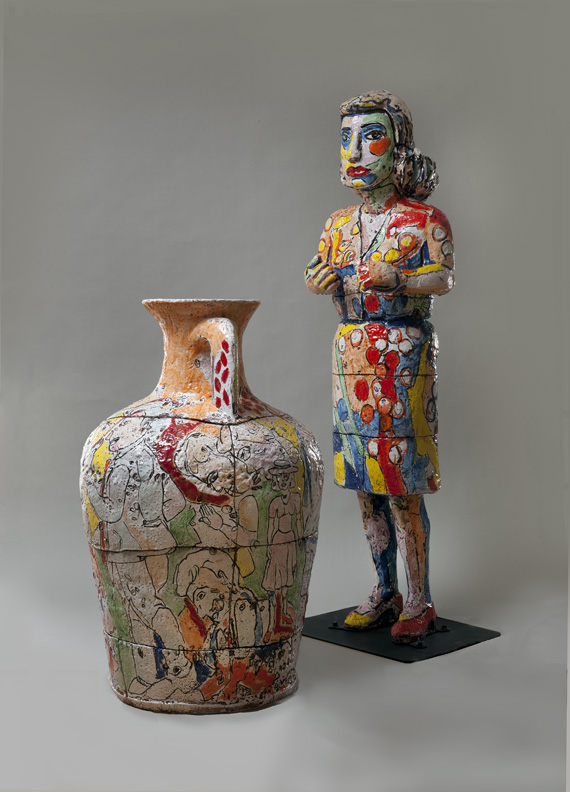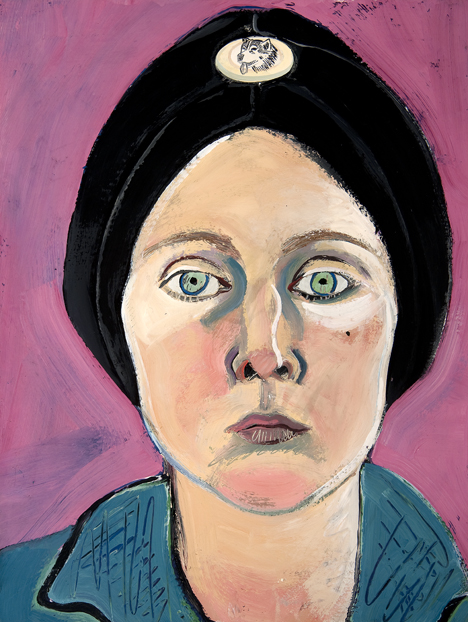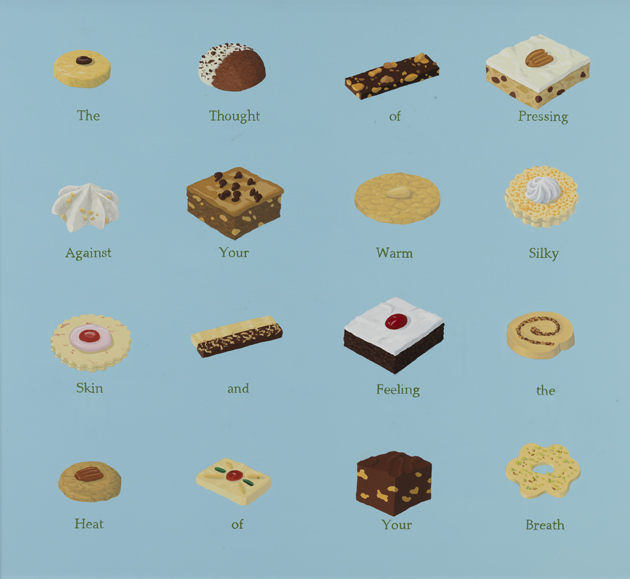
Ken Johnson had a few bad weeks last fall. On November 8th in The New York Times, he wrote a brief preview of the Pennsylvania Academy of the Fine Arts’ The Female Gaze: Women Artists Making Their World that many found sexist. What made Johnson’s few sentences so astounding is that he ought to have taken a breather after digging himself into a hole with an October 25th review of Now Dig This! Art and Black Los Angeles, 1960-1980, at MoMA PS1, in which his readers found objectionable white male bias.
On February 10th at PAFA, several hundred people gathered on the second floor to attend a forum featuring Ken Johnson, along with Kimberly Brooks (artist and founding editor of Huffington Post Arts), and artists Njideka Akunyili and Joyce Kozloff. The panel was moderated by University of Pennsylvania Professor Gwendolyn DuBois Shaw. It was a mistake not to put a second man on the panel; Johnson was frequently and unfairly expected to answer for the patriarchy. Moreover, the conversation focused heavily on his opinions, attributing greater importance to Johnson than to the other panelists, not to mention the lack of specific discussion of the exhibit itself.
The Female Gaze is a large and wide ranging show, though it does not reflect the incredible experimentation in art produced during the thirty years Linda Lee Alter amassed her collection of art by women from the 1980s until 2010. The exhibit includes precious little photography (I spied a Justine Kurland), no video that I noticed, and almost no specifically conceptual art (Jenny Holzer makes an appearance). Among the 200+ works on display there is more than enough first-rate work, yet there is also a substantial quantity that is mediocre and forgettable. Such unevenness is bound to occur when a large collection is focused on living artists, as Alter commendably chose to do. What looks powerful in 1992 may end up looking bland or tedious in 2013, but Alter is an artist herself and was obviously unafraid of taking such risks. This exhibit would have benefited from additional editing, but when someone donates a collection there is probably pressure to show a big chunk of it.

Before the discussion got underway, I was concerned that the event would amount to a lame mea culpa by Johnson, but I needn’t have worried. Johnson was having none of it. When the moderator tried to score cheap shots—for example in discussing researching an artist’s context—she asked him, “Could you imagine yourself reading a book?” He just stared at her in relaxed disbelief, which was a surprisingly effective defense. DuBois Shaw could have saved herself the effort, because over the course of two hours, Johnson managed to score plenty of points against himself, for example when he declared he has “a lot of dumb readers.”
For those just tuning in to this controversy, his inflammatory sentences on The Female Gaze read as follows:
…the day that any woman earns the big bucks that men like Jeff Koons and Damien Hirst rake in is still a long way off. Sexism is probably a good enough explanation for inequities in the market. But might it also have something to do with the nature of the art that women tend to make? Anyone with a theory about that will have a good opportunity to test it…
There are multiple problems here. For example, Koons and Hirst are practically poster boys for When Bad Art Earns Big Money (Johnson likes Koons). But what really set people off was Johnson’s question as to whether “the art that women tend to make” is also responsible for their lagging behind men in the marketplace. In the on-line debate that followed, several of his defenders suggested that Johnson was cleverly posing this question in order to undermine it. As Deven Golden wrote in Art Critical, “he was attempting to stir up interest in another large group exhibition, making a bit of controversy by questioning his own assertion of sexism in the art world.” Perhaps one could reasonably give Johnson the benefit of the doubt.

But the very notion that there exists “art that women tend to make” is unacceptably reductive. Johnson’s phrasing ignores the infinite, individual diversity among women artists in favor of a vague yet monolithic sexist stereotype. Art Fag City was one of several publications to identify this false note. And indeed, one of the more interesting moments of the forum centered on this very issue.
As in most panels, conversation and questions from the audience veered wildly all over the place, but at one point Johnson began to discuss the exhibit’s title in terms of Laura Mulvey’s famous essay Visual Pleasure and Narrative Cinema (1973), in which she coined the term male gaze. He offered that the male gaze seeks to “master, dominate, and make history,” while the female gaze “sympathizes, relates, appreciates, and nurtures.” He went on to say that this explains why, among the more than 200 works in the exhibit, he found “nothing competitive in this show. “ This is a remarkable statement considering the galleries include Alice Neel, Sarah MacEneaney, Louise Bourgeois, Judith Schaechter, Kara Walker, Kiki Smith, Nancy Spero, and Alicia Henry—to name just a few whose work looks more than competitive.
Dubois Shaw correctly pointed out that Johnson’s binary division of artists into male and female gazers is problematic and needs to be questioned. His short list of attributes for each gaze belongs to outmoded gender stereotypes of the 20th century. By coincidence, 2013 is the fiftieth anniversary of Betty Friedan’s earthquake of a book, The Feminine Mystique; by now we should know better than to embrace the archaic gender roles she so effectively smashed. It’s about time we discarded totalizing ideas about racial identity or what men and women are (as exemplified by their “gaze” or anything else). Such generalizations obscure far more than they reveal, but this exhibition’s regrettable title plays right into these clichés.

The most pointed observation of the day belonged to Joyce Kozloff. Throughout the panel, she was secretly jotting down the name of every individual Johnson referenced. Toward the end, she pointed out to him that with the exception of Mulvey, every single person he cited was a white male: Clement Greenberg, Peter Schjeldahl, Jeff Koons, Jed Perl, Michael Kimmelman, David Salle, and Frank Stella. His response was to shrug his shoulders and remark, “I mentioned famous people.” In this exchange, Kozloff neatly laid bare the self-perpetuation of privilege. Ken Johnson is an influential critic whose frame of reference consists of a canon of artists and writers that has excluded most everyone but white men, and inevitably, this framework shapes his critiques.
His review of Now Dig This! reflects some of this bias. In considering August the Squared Fire (1965) by Melvin Edwards, Johnson writes:
Formally, you have a dialogue between stasis and dynamism, and psychologically, between reason and feeling. Such dualities would be enough on which to base judgment and interpretation were this a piece by, say, the white junk sculptor Richard Stankiewicz. But it makes a difference to know that Mr. Edwards is African-American and has for decades been producing small, wall-mounted assemblages of industrial steel parts called “The Lynch Fragments.”
Johnson is right when he says we need to account for the fact that Edwards is African-American and discusses the specific context of the Watts uprising in August 1965. But he is wrong when he supposes that we don’t have to consider context when the artist is white.
Johnson treats the work of white male artists as somehow neutral and universally accessible, using as an example Duchamp’s snow shovel titled “In Advance of the Broken Arm.” Johnson describes it as “a piece of deracinated, intellectual mischief-making designed to question relations between language and reality.” The idea of deracination is illusory and out of touch with 21st century discourse. To understand Duchamp’s snow shovel when he made the piece in 1915, one had to be an initiate in both historical and contemporary developments in western art, a foundation that was difficult to come by if you were a woman at the time, and almost completely unavailable if you were not white. The fact that a white male position is more implicit than explicit in the snow shovel is also an expression of the social privilege Duchamp enjoyed. As the saying goes, rich people don’t need to talk about money.
Despite some of his questionable assumptions, Johnson has a specific and thoughtful beef with identity politics in art, which he took pains to articulate during the panel. “Art is not utilitarian, and it is not a form of politics,” he argued, so one “cannot judge art based on its ideology.” Essentially, he resists any consideration of art that values ethics at the expense of aesthetics. This line of thinking has its roots in Kant, whose Critique of Judgment argued that opinions about beauty cannot be based on an object’s usefulness nor its relation to what is morally good. For Johnson, therefore, art whose purpose is to advance a political agenda is not compelling, even if that agenda is ethically laudable. Johnson said he is interested in “where culture meets the unknown.” Great art is paradoxical, he believes, and the problem is that “people want to oversimplify. When you’re wading around in paradoxical waters you can drown. Art is about feeling, and writing about art is not science. I’d rather be intemperate than responsible.”
Johnson, like most people, is plenty paradoxical himself. On the one hand, his writing on Now Dig This! and The Female Gaze contains passages that I find wrong-headed, and his errors seem closely linked to how deeply rooted he is in a clubby band of white male writers and artists that persists in justifying itself as strictly meritocratic. On the other hand, he is well aware of the white male power structure in art and able to criticize it. One of the more memorable moments in the panel came when Johnson described the Whitney Museum’s Wade Guyton: OS show as “the epitome of belief in the next Great White Hope,” the art world’s attempt to anoint, in his words, a “white male presentable avatar.”
Interestingly, Johnson followed his analysis of the Guyton exhibit with this comment: “art, above all, brings out people’s stereotyped mental structures, clichés, and fixed ideas.” It would seem worth his while to bear this insight more sharply in mind.
This article is presented in partnership with Title Magazine, an online forum for substantive discussion and critical analysis of the arts in Philadelphia.




